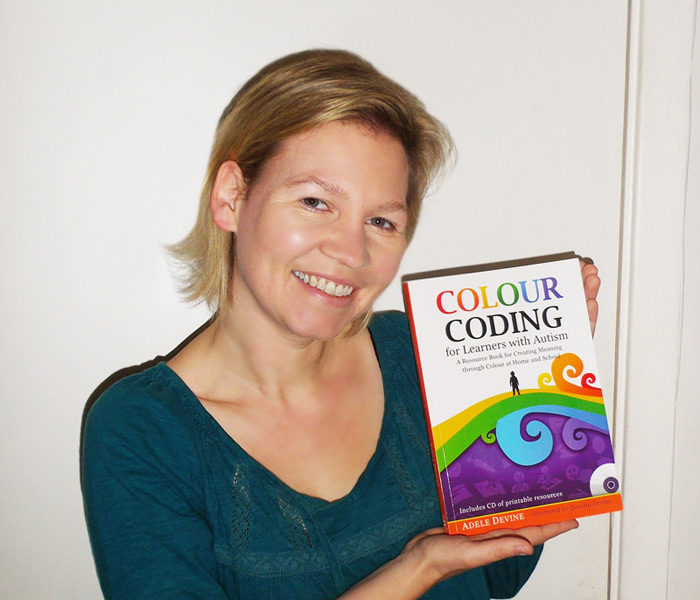No SEND Child Should Have to Miss Out on Play

To help special children learn to have fun, we must be willing to interact on their terms, explains Adele Devine…

- by Adele Devine
- Early years and SEN specialist, author, keynote speaker and trainer Visit website

Joe loves cars. You know this because you chatted about it at his home visit. Mum said he likes his own space and won’t play with other children. To help Joe settle you have put out the cars and the toy garage. When Joe arrives he takes a blue car and retreats to a far corner of the room. He lies on the floor and examines the car. He seems fixated on the wheels and shows no interest in anything else. Left to his own ‘child-led’ devices he could stay like this all day. So what can you do?
a) Take Joe’s hand and lead him back to the toy garage and the children who are now playing with it. Joe pulls his hand back. He starts to wail loudly because he now feels unsafe and unsure of you and your demands. He continues to sob for over an hour. You call Mum, who comes to rescue him.
b) You bring the garage and the cars to Joe. The other children follow, but Joe gets up and takes his car to a far corner of the room and stays there.
c) You try intensive interaction (intensiveinteraction.org) You find a similar car and go and lie down (near enough so that Joe can see you, but far enough that he doesn’t feel the need to move). You play with the car in just the same way as him. If Joe vocalises, you vocalise. You are not making any demands. You are not ‘invading’. You are showing a similar interest, and that you value and respect how he plays. You are showing that you know how to play too.
In time Joe’s confidence increases. He starts to explore moving the car along the radiator. You move your car too. You smile lots and show that you think he has great ideas.
More time passes. You build a ramp from the radiator and the cars travel down it. You get more cars. Another child sees the fun game you have created and brings a car to have a go. You start to see some turn-taking and interactions.
One day Joe arrives and gets a car, but he doesn’t go to the back of the room. He puts the car down the ramp. He does this quite a few times.
Another child comes to play too and this time Joe doesn’t move away.
Given the time, space and correct levels of interaction, all children can play.
Final thoughts
It’s said Albert Einstein once observed that, “Play is the highest form of research”. Many of our greatest original thinkers would have been unconventional in their play/early research.
10 things that will encourage play…
- Role models – children learn by watching others play
- Interests – learn motivators at your home visit
- Removing pressures – be truly child-led
- Smiles and laughter – create a happy, loving atmosphere
- Role play – stage simple, funny games
- Fewer words – this helps the child process
- Intuition – know when to interact and stop
- Visuals – help them decode your meaning
- Observe – learn what gets their attention
- Repetition – have the same props available
Simple props for play
- Balls – throw a big soft ball high in the air and catch it
- Floor spots – jump from spot to spot naming colours
- Washing liquid and straws – add some water and blow
- Bubbles – jump and pop them!
- Sheet – hide under it and let the children uncover you
- Puppet – make the lion roar, chase and tickle
- Blanket – roll a willing child up in a ‘sausage roll’
- Tickle sticks – tickles with sparkly cheerleader pompoms
- Bench – walking the plank (with a hungry crocodile waiting…)
- Soft play balls and guttering – let the balls roll down again and again
Adele Devine is a teacher at Portesbery school and director of SEN Assist.
It’s a great game and we repeat it often – and each time we do, Wilf’s “Wake up!” gets clearer and louder, and his confidence increases. I am so proud of Wilf, and it is so exciting to hear his voice.
Key ingredients
10 things that will encourage play…
- Role models – children learn by watching others play
- Interests – learn motivators at your home visit
- Removing pressures – be truly child-led
- Smiles and laughter – create a happy, loving atmosphere
- Role play – stage simple, funny games
- Fewer words – this helps the child process
- Intuition – know when to interact and stop
- Visuals – help them decode your meaning
- Observe – learn what gets their attention
- Repetition – have the same props available
Simple props for play
- Balls – throw a big soft ball high in the air and catch it
- Floor spots – jump from spot to spot naming colours
- Washing liquid and straws – add some water and blow
- Bubbles – jump and pop them!
- Sheet – hide under it and let the children uncover you
- Puppet – make the lion roar, chase and tickle
- Blanket – roll a willing child up in a ‘sausage roll’
- Tickle sticks – tickles with sparkly cheerleader pompoms
- Bench – walking the plank (with a hungry crocodile waiting…)
- Soft play balls and guttering – let the balls roll down again and again
Adele Devine is a teacher at Portesbery school and director of SEN Assist.
I feel so proud of Leo for conquering his fears and deciding to have a go.
Case study – ‘Wilf “wake up” teacher’
Encouraging interactions Wilf is a very curious little man who likes to challenge himself by climbing. He climbs on the cupboards, the radiators and the windowsills. I know from mum that he is capable of scaling the garden fence.
He’s quite impressive. We get a climbing frame in class so that Wilf has another place to climb. We discover he also loves bubbles, balloons, balls and anything new and exciting. We use these things to encourage interactions.
The climbing reduces as he gets positive feedback and attention through the other clever things we do.
Growing confidence Wilf starts to get more playful. One day he goes to lie on the bench. I get him a pillow and blanket, and he pretends to be asleep (even fake snoring). Great role play!
He starts to copy marching and star jumps. We develop a lovely sequence where we march, then star jump, then fall to the ground and pretend to sleep. Wilf jumps up and shouts “Wake up!” at me, and I wake with a big jump.
It’s a great game and we repeat it often – and each time we do, Wilf’s “Wake up!” gets clearer and louder, and his confidence increases. I am so proud of Wilf, and it is so exciting to hear his voice.
Key ingredients
10 things that will encourage play…
- Role models – children learn by watching others play
- Interests – learn motivators at your home visit
- Removing pressures – be truly child-led
- Smiles and laughter – create a happy, loving atmosphere
- Role play – stage simple, funny games
- Fewer words – this helps the child process
- Intuition – know when to interact and stop
- Visuals – help them decode your meaning
- Observe – learn what gets their attention
- Repetition – have the same props available
Simple props for play
- Balls – throw a big soft ball high in the air and catch it
- Floor spots – jump from spot to spot naming colours
- Washing liquid and straws – add some water and blow
- Bubbles – jump and pop them!
- Sheet – hide under it and let the children uncover you
- Puppet – make the lion roar, chase and tickle
- Blanket – roll a willing child up in a ‘sausage roll’
- Tickle sticks – tickles with sparkly cheerleader pompoms
- Bench – walking the plank (with a hungry crocodile waiting…)
- Soft play balls and guttering – let the balls roll down again and again
Adele Devine is a teacher at Portesbery school and director of SEN Assist.
There is no right way to play and we must take care not to dictate. But if a child appears to be self-soothing or trying to ‘zone out’ then we should interact on their terms, follow their unique lead and become a stepping stone to play.
Case study – ‘Leo the little rocker’
Small steps Leo loves the motion of rocking. The rocking horse makes him feel comfortable, happy and safe. When Leo first started school we took the rocker with us when we made big transitions. It was a bit too big to carry comfortably and not a lasting strategy, but it really helped reduce his anxiety.
Leo may seem to be in ‘in his own little world’, but he is constantly watching and observing the other children. His parents start to see him develop play with his big brother at home (in his safest space).
He is starting to try racing and ball play. These are things he sees a lot at school, but is not quite ready to join in with.
The breakthrough I am videoing my amazing lead assistant, Lynne, playing with the other children. She is pretending to be a lion and when they run to her, she growls and tickles them.
Leo is on his rocker while all this goes on, but all of a sudden Leo gets up and runs over. After all that watching he has built the confidence to join in the game.
I feel so proud of Leo for conquering his fears and deciding to have a go.
Case study – ‘Wilf “wake up” teacher’
Encouraging interactions Wilf is a very curious little man who likes to challenge himself by climbing. He climbs on the cupboards, the radiators and the windowsills. I know from mum that he is capable of scaling the garden fence.
He’s quite impressive. We get a climbing frame in class so that Wilf has another place to climb. We discover he also loves bubbles, balloons, balls and anything new and exciting. We use these things to encourage interactions.
The climbing reduces as he gets positive feedback and attention through the other clever things we do.
Growing confidence Wilf starts to get more playful. One day he goes to lie on the bench. I get him a pillow and blanket, and he pretends to be asleep (even fake snoring). Great role play!
He starts to copy marching and star jumps. We develop a lovely sequence where we march, then star jump, then fall to the ground and pretend to sleep. Wilf jumps up and shouts “Wake up!” at me, and I wake with a big jump.
It’s a great game and we repeat it often – and each time we do, Wilf’s “Wake up!” gets clearer and louder, and his confidence increases. I am so proud of Wilf, and it is so exciting to hear his voice.
Key ingredients
10 things that will encourage play…
- Role models – children learn by watching others play
- Interests – learn motivators at your home visit
- Removing pressures – be truly child-led
- Smiles and laughter – create a happy, loving atmosphere
- Role play – stage simple, funny games
- Fewer words – this helps the child process
- Intuition – know when to interact and stop
- Visuals – help them decode your meaning
- Observe – learn what gets their attention
- Repetition – have the same props available
Simple props for play
- Balls – throw a big soft ball high in the air and catch it
- Floor spots – jump from spot to spot naming colours
- Washing liquid and straws – add some water and blow
- Bubbles – jump and pop them!
- Sheet – hide under it and let the children uncover you
- Puppet – make the lion roar, chase and tickle
- Blanket – roll a willing child up in a ‘sausage roll’
- Tickle sticks – tickles with sparkly cheerleader pompoms
- Bench – walking the plank (with a hungry crocodile waiting…)
- Soft play balls and guttering – let the balls roll down again and again
Adele Devine is a teacher at Portesbery school and director of SEN Assist.










